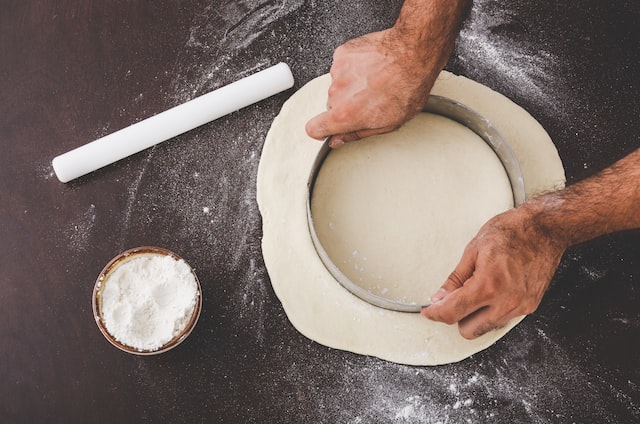Bread flour and all purpose flour are two types of flour that can be used for baking. Bread flour has a higher protein content than all purpose flour, which gives it a higher gluten content. This makes bread flour better for making yeast breads, as the higher gluten content helps to trap the carbon dioxide gas that is produced by the yeast. All purpose flour can be used for making yeast breads, but it will not produce as light and fluffy a result as bread flour.
What is bread flour?
(Image by Pexels from Pixabay )

Bread flour is a type of flour that is specifically designed for use in baking bread. It is made from hard wheat, which has a higher protein content than other types of wheat. This protein gives bread flour its strength, which allows it to produce a more consistent loaf of bread with a better rising action.
What is all purpose flour?
(Photo by Pablo Lancaster Jones on Unsplash )

All purpose flour, also known as plain flour, is a type of milled wheat flour that is most commonly used in baking. It is made from a blend of hard and soft wheat flours and has a medium gluten content. All purpose flour can be used for a variety of baked goods, such as breads, cakes, cookies, and pies.
Bread flour Vs. All purpose flour – Key differences
Bread flour and all-purpose flour are two types of flour commonly used in baking. The main difference between these two types of flour is their protein content.
Bread flour typically has a higher protein content than all-purpose flour. The protein in bread flour, which is usually around 12-14%, forms gluten when mixed with water. Gluten is a network of proteins that gives bread dough its structure and elasticity, allowing it to rise and hold its shape during baking.
All-purpose flour, on the other hand, has a lower protein content, usually around 8-11%. While all-purpose flour can also form gluten, it is not as strong as the gluten formed with bread flour. This makes all-purpose flour a more versatile option for baking, as it can be used in a wide variety of recipes, from cakes and cookies to bread and pizza dough.
Overall, if you are looking to make bread or other baked goods that require a strong, elastic dough, bread flour is the better option. If you are making something that does not require as much structure, such as cakes or muffins, all-purpose flour will work just fine.
How to use bread flour and all purpose flour
Bread flour and all-purpose flour can be used interchangeably in some recipes, but it’s important to note that they do have different properties and may affect the texture and rise of your baked goods. Here are some tips on how to use each type of flour:
Bread Flour:
- Use bread flour for recipes that require a strong, elastic dough, such as bread, pizza dough, and bagels.
- Bread flour is ideal for recipes that require a long rising time, as the extra protein helps the dough to maintain its structure and rise properly.
- When using bread flour, you may need to adjust the amount of liquid in your recipe, as it absorbs more liquid than all-purpose flour.
All-Purpose Flour:
- All-purpose flour is a versatile option that can be used in a wide variety of recipes, including cakes, cookies, muffins, and quick breads.
- Use all-purpose flour for recipes that do not require as much structure, such as cakes and cookies.
- When using all-purpose flour in place of bread flour, you may need to add extra ingredients such as eggs or milk to help give the dough structure and rise properly.
In general, it’s best to follow the recipe’s instructions for which type of flour to use. If a recipe calls for bread flour, it’s likely because the recipe needs the extra structure and gluten that bread flour provides. Similarly, if a recipe calls for all-purpose flour, it’s because the recipe does not require as much structure or gluten.
The health benefits and drawbacks of bread flour
Bread flour is a type of flour that is typically made from hard wheat and has a higher protein content than other types of flour. Here are some of the potential health benefits and drawbacks of using bread flour:
Benefits:
- High in protein: Bread flour is high in protein, which is important for building and repairing muscles, tissues, and cells in the body.
- Contains essential nutrients: Bread flour also contains essential nutrients such as iron, B vitamins, and fiber.
- Helps with digestion: The fiber in bread flour can help promote healthy digestion and prevent constipation.
Drawbacks:
- May cause digestive issues: The high protein content in bread flour can be difficult for some people to digest, especially those with gluten sensitivities or celiac disease.
- May contribute to weight gain: Bread flour is also high in carbohydrates, which can contribute to weight gain if consumed in excess.
- May be highly processed: Some bread flour products may be highly processed and may contain additives such as preservatives or synthetic vitamins and minerals.
Bread flour does have some potential health benefits, it is important to consider the potential drawbacks as well. If you have gluten sensitivities or celiac disease, it’s important to avoid bread flour and other gluten-containing products. Additionally, if you are trying to manage your weight, it’s important to consume bread flour in moderation as part of a balanced diet. When possible, choose whole grain bread flour options and minimize processed additives.
The health benefits and drawbacks of all purpose flour
All-purpose flour is a type of flour that is made by milling wheat grains and removing the bran and germ, resulting in a flour with a finer texture and longer shelf life. Here are some of the potential health benefits and drawbacks of using all-purpose flour:
Benefits:
- Versatile: All-purpose flour can be used in a wide variety of recipes, from cakes and cookies to bread and pizza dough.
- Contains essential nutrients: All-purpose flour contains essential nutrients such as iron, B vitamins, and fiber.
- Convenient: All-purpose flour is widely available and easy to use, making it a convenient option for home baking.
Drawbacks:
- Lower in nutrients: All-purpose flour is less nutritious than whole wheat flour or other whole grain flours, as it has been stripped of its bran and germ.
- May contribute to weight gain: Like bread flour, all-purpose flour is high in carbohydrates, which can contribute to weight gain if consumed in excess.
- May be highly processed: Some all-purpose flour products may be highly processed and may contain additives such as preservatives or synthetic vitamins and minerals.
All-purpose flour does have some potential health benefits, it is important to consider the potential drawbacks as well. When possible, choose whole grain all-purpose flour options or mix all-purpose flour with other flours for added nutrition. Additionally, it’s important to consume all-purpose flour in moderation as part of a balanced diet.
What flour is best for baking cake?
The type of flour that is best for baking cake depends on the type of cake you are making and the desired texture. In general, cake flour is often recommended for baking cakes, as it is a low protein flour that produces a fine crumb and tender texture. Cake flour is also often bleached, which further improves its texture and ability to absorb liquids.
If you don’t have cake flour on hand, you can substitute it with all-purpose flour by reducing the amount of flour by 2 tablespoons per cup and adding 2 tablespoons of cornstarch per cup of flour. This will help mimic the texture of cake flour.
Alternatively, you can also use pastry flour, which is another low protein flour that is similar to cake flour. Pastry flour has a slightly higher protein content than cake flour, which makes it a good option for cakes that need a little extra structure, such as pound cakes.
Overall, the best flour for baking cake depends on the recipe and the desired texture. Cake flour, all-purpose flour with cornstarch, or pastry flour can all be used to make delicious cakes.
What happens if I use all-purpose flour for bread?
Using all-purpose flour for making bread can result in a loaf that is less than ideal in terms of texture and structure. This is because all-purpose flour has a lower protein content compared to bread flour, which is specifically formulated for making bread.
The protein in bread flour, also known as gluten, gives bread its characteristic chewy texture and allows it to rise properly. All-purpose flour, on the other hand, has less gluten, which can result in a denser, flatter loaf.
However, if you don’t have bread flour on hand and want to use all-purpose flour, you can still make bread. There are a few things you can do to improve the texture and structure of the bread:
- Add vital wheat gluten: You can add vital wheat gluten to the all-purpose flour to increase its protein content. This will help the bread rise and give it a better texture. Follow the package instructions for the amount to add.
- Use a bread improver: You can also use a bread improver, which is a mixture of enzymes and other ingredients designed to improve the texture and rise of bread. Follow the package instructions for the amount to add.
- Knead the dough well: Kneading the dough for a longer period of time can help develop the gluten in the flour, resulting in a better-textured loaf.
- Let the dough rise longer: Allowing the dough to rise for a longer period of time can also help improve the texture of the bread.
In summary, using all-purpose flour for bread may not give you the same results as using bread flour, but with some modifications to the recipe and technique, you can still make a decent loaf of bread.








